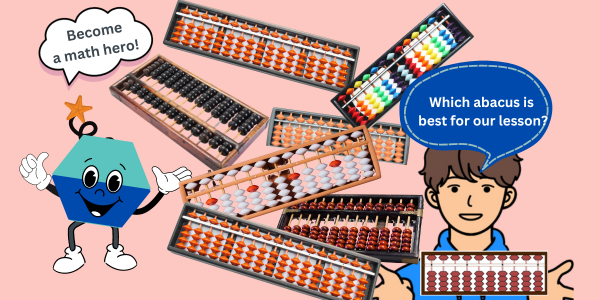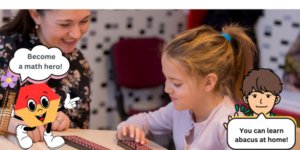Are you excited to introduce your child to the amazing world of abacus learning? But maybe you’re not sure which abacus would be best for them? Don’t worry! Let me share from my own experience and help you pick the perfect one for our abacus lessons together!
The Best Abacus for Beginners
When browsing for abacuses on Amazon, you’ll find many selections with diverse features, including different sizes, colors, materials, types, and price ranges. The most common and recommended abacus for beginners and is the 23-column abacus. It’s the standard choice for many abacus learners and widely used in abacus schools in Japan (Please take a moment to review the “Tips for Parents” below to select the appropriate abacus for very young children).
Why 23 Columns is the best?
You might want to start with a smaller abacus, like one with 13-17 columns, for learning addition and subtraction. But as your child progresses, they’ll need a longer one for multiplication and division. So, you might end up getting a bigger one as they get better. The 23-column abacus is great because it has enough columns for most calculations your child will do while learning. Using fewer columns might limit what they can practice, while more columns could be a bit too much for young beginners.
Materials Matter
Plastic beads are very popular on Amazon, with some being colorful and appealing at a lower cost. While parents may be inclined to choose them, it’s essential to acknowledge the drawbacks of plastic beads. They don’t provide the same tactile feedback as wooden beads, which are crucial for developing a good sense of touch and rhythm in abacus use. Additionally, as an experienced abacus learner, I’ve noticed a significant difference between plastic and wooden beads. Most plastic beads are too light to manipulate the beads quickly and effectively.
Price Range
Abacus prices can vary widely. For example, the reliable and high-quality Japanese-made Tomoe Soroban costs $36 (23-column, no reset button) and $56 (23-column, with reset button) on Amazon. In contrast, a 23-column plastic bead abacus costs around $13.
I have personally tried various types of abacuses available on Amazon and was surprised by the differences in bead size, shape, and smoothness. I plan to write a detailed abacus comparison blog soon. In the meantime, if you choose a Made in Japan abacus, such as those from Tomoe or Unshudo, you can expect a high-quality product. However, be aware that “Japanese abacus” does not always mean the abacus is made in Japan.
One-Touch Abacus
Another option to consider is the “one-touch abacus.” This handy tool lets you reset the beads with a single button, making it quicker and easier to clear the abacus. This can be especially helpful for beginners who might find the manual resetting process a bit tedious. Plus, it’s a must-have for advanced abacus learners, particularly for those participating in competitions or certificate exams where speed and efficiency are key.
It’s a good idea to get a one-touch abacus while your child is still a beginner. If you wait until they’re more advanced, they might have already developed a rhythm and muscle memory for the traditional method, and switching could throw them off a bit
Tips for Parents
Start Simple: For very young children, like preschoolers or first graders, a 17-column plastic abacus can be a great starting point. These shorter abacuses are easier for small hands to manage. When I started learning abacus in kindergarten, I used a 23-column abacus right from the start. I’ve seen kids use both bigger and smaller abacuses, and each has its own benefits. It’s all about finding what works best for your child’s little hands and growing skills!
Upgrade as Needed: As your child progresses, consider moving to a 23-column wooden abacus. This will accommodate more complex calculations and help them get used to the standard tool used in more advanced abacus learning. This way, they’ll be well-prepared for bigger challenges as they grow.
Quality Matters: If possible, invest in a good-quality abacus from the beginning. It can make a big difference in your child’s learning experience and boost their enthusiasm for using the tool. Starting with the best will set them up for success and make learning even more fun.
Conclusion
Choosing the right abacus for your child doesn’t have to be complicated. By opting for a 23-column wooden abacus from a reputable brand like Tomoe, you’ll set your child up for success in their abacus learning journey. And if your child is just starting out, a 17-column plastic abacus might be a good initial investment. Remember, the key is to find a balance between quality, usability, and your child’s specific needs.




